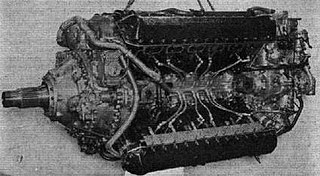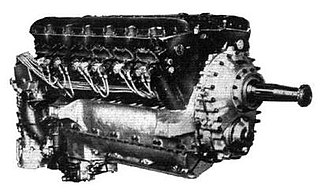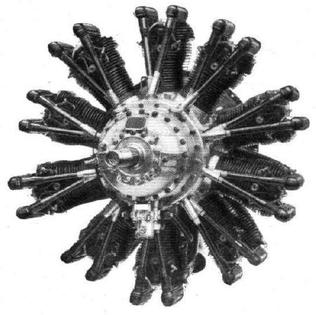
The Bristol Pegasus is a British nine-cylinder, single-row, air-cooled radial aero engine. Designed by Roy Fedden of the Bristol Aeroplane Company, it was used to power both civil and military aircraft of the 1930s and 1940s. Developed from the earlier Mercury and Jupiter engines, later variants could produce 1,000 horsepower (750 kW) from its capacity of 1,750 cubic inches by use of a geared supercharger.

The Bristol Mercury is a British nine-cylinder, air-cooled, single-row, piston radial engine. Designed by Roy Fedden of the Bristol Aeroplane Company it was used to power both civil and military aircraft of the 1930s and 1940s. Developed from the earlier Jupiter engine, later variants could produce 800 horsepower (600 kW) from its capacity of 1,500 cubic inches by use of a geared supercharger.

The Napier Sabre is a British H-24-cylinder, liquid-cooled, sleeve valve, piston aero engine, designed by Major Frank Halford and built by D. Napier & Son during World War II. The engine evolved to become one of the most powerful inline piston aircraft engines in the world, developing from 2,200 hp (1,600 kW) in its earlier versions to 3,500 hp (2,600 kW) in late-model prototypes.

The Rolls-Royce Vulture was a British aero engine developed shortly before World War II that was designed and built by Rolls-Royce Limited. The Vulture used the unusual "X-24" configuration, whereby four cylinder blocks derived from the Rolls-Royce Peregrine were joined by a common crankshaft supported by a single crankcase. The engine was originally designed to produce around 1,750 horsepower (1,300 kW) but problems with the Vulture design meant that the engines were derated to around 1,450 to 1,550 hp in service by limiting the maximum rpm.

The Kestrel or type F is a 21 litre 700 horsepower (520 kW) class V-12 aircraft engine from Rolls-Royce, their first cast-block engine and the pattern for most of their future piston-engine designs. Used during the interwar period, it provided excellent service on a number of British fighters and bombers of the era, such as the Hawker Fury and Hawker Hart family, and the Handley Page Heyford. The engine also sold to international air forces, and it was even used to power prototypes of German military aircraft types that were later used during the Battle of Britain. Several Kestrel engines remain airworthy today.

The Rolls-Royce Eagle Mk XXII is a British 24-cylinder, sleeve valve, H-block aero engine of 46 litre displacement. It was designed and built in the early-1940s by Rolls-Royce Limited and first ran in 1944. It was liquid-cooled, of flat H configuration with two crankshafts and was capable of 3,200 horsepower at 18 psi boost.

The Rolls-Royce Condor aircraft piston engine was a larger version of the Rolls-Royce Eagle developing up to 675 horsepower (500 kW). The engine first ran in 1918 and a total of 327 engines were recorded as being built.

The Rolls-Royce Goshawk was a development of the Rolls-Royce Kestrel that used evaporative or steam cooling. In line with Rolls-Royce convention of naming piston engines after birds of prey, it was named after the goshawk.

The Armstrong Siddeley Cheetah is a seven-cylinder British air-cooled aircraft radial engine of 834 cu in capacity introduced in 1935 and produced until 1948. Early variants of the Cheetah were initially known as the Lynx Major.

The Armstrong Siddeley Leopard was a British 14-cylinder twin-row air-cooled radial aero engine developed in 1927 by Armstrong Siddeley. It was the most powerful radial engine in the world when introduced.

The Armstrong Siddeley Jaguar was an aircraft engine developed by Armstrong Siddeley. The Jaguar was a petrol-fuelled air-cooled 14-cylinder two-row radial engine design. The Jaguar III was first used in 1923, followed in 1925 by the Jaguar IV and in 1927 by the Jaguar VI. In 1925 the Jaguar became the first production aero engine incorporating a geared supercharger.

The Armstrong Siddeley Mongoose is a British five-cylinder radial aero engine produced by Armstrong Siddeley. Developed in the mid-1920s it was used in the Hawker Tomtit trainer and Parnall Peto seaplane amongst others. With a displacement of 540 cubic inches (9 litres) the Mongoose had a maximum power output of 155 horsepower (115 kilowatts).

The Armstrong Siddeley Serval was a British ten-cylinder aero engine developed by Armstrong Siddeley in the late 1920s. Following company tradition, the engine was named for the serval.

The Rolls-Royce Exe, or Boreas, was a 24-cylinder air-cooled X block sleeve valve aircraft engine intended primarily for the new Fairey Fleet Air Arm aircraft, particularly the Fairey Barracuda. The Exe was relatively powerful for its era, producing about 1,100 hp (820 kW). This is notable given the relatively small 1,300 cubic inches (22 L) displacement, the Merlin requiring 1,600 cubic inches (27 L) for approximately the same power level. The X-24 layout made this quite a compact engine.

The Armstrong Siddeley Tiger was a British 14-cylinder air-cooled aircraft radial engine developed by Armstrong Siddeley in the 1930s from their Jaguar engine. The engine was built in a number of different versions but performance and dimensions stayed relatively unchanged. The Tiger VIII was the first British aircraft engine to use a two-speed supercharger.

The Napier Dagger was a 24-cylinder H-pattern (or H-Block) air-cooled engine designed by Frank Halford and built by Napier before World War II. It was a development of the earlier Napier Rapier.

The Napier Rapier was a British 16-cylinder H pattern air-cooled aero engine designed by Frank Halford and built by Napier & Son shortly before World War II.

The Siddeley Tiger was an unsuccessful British aero engine developed shortly after the end of World War I by Siddeley-Deasy. Problems encountered during flight testing caused the project to be cancelled.

The Armstrong Siddeley Deerhound was a large aero engine developed by Armstrong Siddeley between 1935 and 1941. An increased capacity variant known as the Boarhound was never flown, and a related, much larger, design known as the Wolfhound existed on paper only. Development of these engines was interrupted in April 1941, when the company's factory was bombed, and on 3 October 1941 the project was cancelled by the Air Ministry.
The Fairey P.16 Prince was a British experimental 1,500 hp 16-cylinder H-type aircraft engine designed and built by Fairey in the late 1930s. The engine did not go into production.



















